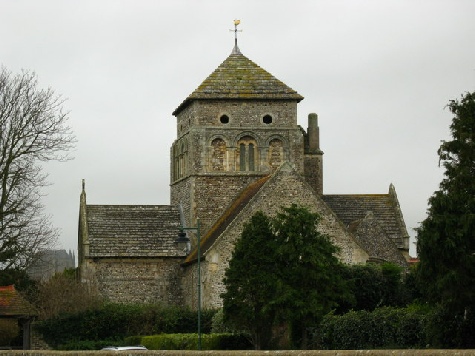



The Parish Church of St George the Martyr, Waterlooville

122. St Nicholas Old Shoreham
This impressive church stands north of the town, not far from the busy A27 road to Brighton, in what was the original village and port in Saxon times. Built in cruciform shape there are still traces of Saxon work at the west end but the main tower and the transepts date from the Norman period (c.1130). The nave and the chancel were added nearly 200 years later.
The main entrance to the church is not easy to find. There is no porch only a small Norman doorway with zig-
In sharp contrast the chancel has a Victorian painted ceiling with Victorian glass in the east window depicting St Wilfrid, St Richard, St Nicholas and Mary the mother of Jesus. Some of the glass was exhibited in the Great Exhibition of 1851. On the chancel wall are two interesting memorials, one dating from the 17th century commemorating Captain Richard Poole, a sailor who died in 1652 aged 94. He commanded a ship which sailed from Shoreham Harbour to attack the Spanish Armada. The other tablet commemorates a family of six children, one of whom Christopher, perished on the Titanic and a younger brother Bernard who was killed at Gallipoli in 1915.
In the nave is a new millennium window designed by Sue Wallis. The design shows a river representing the water of life, a dove representing the Holy Spirit and some fish swimming below. At the west end is a large memorial to Edward Blaker who died in 1678 aged 48 having been a JP and Burgess in Parliament for New Shoreham. His wife Susannah and son William are also commemorated.
In the south transept the World War One Memorial can be seen as well as a list of vicars. Apparently Simon Winch disappeared some time after 1685 and no new vicar was appointed until 1828.
The large churchyard contains many interesting old family tombs. More recent memorials include about ten First World War graves, many relating to Royal Flying Corps officers mostly killed in flying accidents at nearby Shoreham airport. They include a Canadian and a South African. Nearby a sculpted figure on a tombstone commemorates Lydia Yavorska, a Russian princess and actress who died in 1921. She had married an Englishman John Pollock. An inscription states that she was ‘the youngest of four great actresses who devoted their lives to the worship of beauty and the cause of freedom.’
On leaving the tranquillity of this peaceful haven a visit should also be made to the great Norman church of St Mary de Haura in the heart of New Shoreham. It is of cathedral like proportions but sadly on the day I visited locked iron gates prevented access to the nave and chancel.
John Symonds
Country Churches
Easter and Spring Edition 2010
